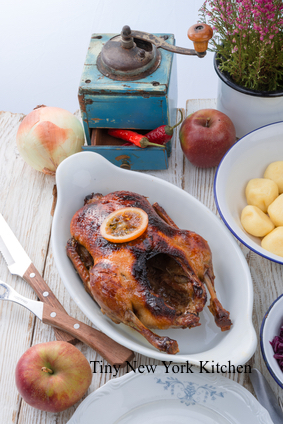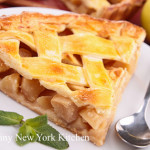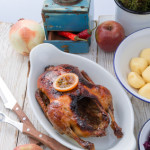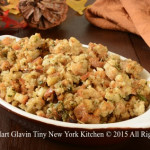Friendsgiving
I’ve had friends, who for years, have been celebrating “Friendsgiving” and look forward to it every year. Friendsgiving is another way to celebrate the season with those who mean the most to you. A friend-focused feast is a great way to include those who don’t have plans on Thanksgiving or to try those new recipes you’ve been checking out. Whether you celebrate on Thanksgiving Day itself or hold a separate dinner altogether, Friendsgiving is a tradition that we, at Tiny New York Kitchen, can get behind.
“Work With What You Got!”
© Victoria Hart Glavin Tiny New York Kitchen © 2016 All Rights Reserved
Lattice Crust 101
Creating a lattice crust isn’t as difficult as it looks. Follow these easy steps and you’ll have a pretty and traditional looking pie.
Using a pastry cutter or knife, cut pie crust into 1 inch strips. Trim off the ends.
Lay on top of the filling, leaving a 1 inch space between each piece. Overlap each piece to form a lattice.
Secure the edges by pressing down onto crust with a fork. Trim off any excess dough.
www.tinynewyorkkitchen.com
“Work With What You Got!”
© Victoria Hart Glavin Tiny New York Kitchen © 2016 All Rights Reserved
Peeps!
Tiny New York Kitchen Wishes You & Your Family A Very Happy Easter!
Happy Sunday! The Fourth Candle On The Advent Wreath Is Lit. Christmas Is Nearly Here.
New York City is a wonderful place to be during the Christmas season. Store windows are decorated and the streets are a bustle with shoppers and tourists.

How To Roast A Duck
Roasting a whole duck can seem daunting, but once you’re armed with a little knowledge, a perfectly cooked duck is easily within reach.
Choose the right bird. A Pekin (Long Island) duck is best for roasting whole. It’s ideal to slice, has a sweet flavor, has good fat content, and is widely available.
Score it. There’s a ton of wonderful fat layered between the skin and meat of the duck, which is certainly more than you want to eat. So it’s crucial to score the breasts and legs, slicing through the skin and fat. Make sure to stop before you hit the meat. Scoring allows some of that fat goodness to render out.
Use that rendered fat. Store this priceless liquid gold in the refrigerator or freezer and use it to add flavor to everything from salads to popcorn. Duck fat is a chef’s best friend.
“Work With What You Got!”
© Victoria Hart Glavin Tiny New York Kitchen © 2015 All Rights Reserved
Dressing & Stuffing
I get asked this question every year about this time, “what’s the difference between dressing and stuffing?” The answer is that if you live north of the Mason-Dixon line, you probably call this side dish, baked inside a turkey, stuffing. If you’re a Southerner, you probably call it dressing. In classic cooking, it’s called forcemeat. Until Victorian times it was just called stuffing and then all of a sudden “stuffing” seemed indecent, and “dressing” was the new name.
For many years roast turkey meant stuffed turkey. Then all of a sudden health concerns arose about whether or not stuffed birds were safe. While these concerns are real, they shouldn’t affect careful cooks who follow food safety practices. Here are a few simple rules to follow while stuffing your bird.
Stuffing should always be cooked to at least 160 degrees in order to kill any potentially harmful bacteria. When the turkey is done, insert the meat thermometer deep into the center of the body cavity to check the temperature of the stuffing. If it isn’t at least 160 degrees then scoop the stuffing out of the cavity and transfer to a casserole dish. Cover and bake at 350 degrees until the stuffing reaches 160 degrees.
Always prepare your stuffing just before filling and roasting the turkey. NEVER stuff a bird the night before roasting as the turkey cavity provides a warm, moist environment that encourages bacterial growth. To save time on Thanksgiving morning, you can prepare stuffing ingredients the night before. Chop the vegetables, toast the nuts, etc. and then store them in zip lock bags in the refrigerator. If you are super pressed for time you may cook, cool, and refrigerate the seasoning meat and vegetables the night before. Reheat them thoroughly in a large-size skillet before adding to the bread or grains.
Stuffing should be warm when placed in the turkey. Cold stuffing may not cook to 160 degrees by the time the turkey is ready.
NEVER mix raw meat or vegetables into a stuffing. All meat and vegetables should be thoroughly cooked.
To serve the stuffing, remove it from the turkey and place in a serving bowl. Do not allow the stuffing or turkey to stand at room temperature for longer than 2 hours. Refrigerate any leftover stuffing separately from the turkey and use within 2 days. Reheat leftover stuffing thoroughly before serving.
“Work With What You Got!”
© Victoria Hart Glavin Tiny New York Kitchen © 2015 All Rights Reserved
Tiny New York Kitchen Wishes You And Your Family A Very Happy Easter!
















